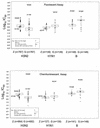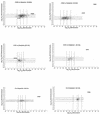Neuraminidase sequence analysis and susceptibilities of influenza virus clinical isolates to zanamivir and oseltamivir
- PMID: 12821478
- PMCID: PMC161875
- DOI: 10.1128/AAC.47.7.2264-2272.2003
Neuraminidase sequence analysis and susceptibilities of influenza virus clinical isolates to zanamivir and oseltamivir
Abstract
The influenza virus neuraminidase (NA) inhibitors zanamivir and oseltamivir were introduced into clinical practice in various parts of the world between 1999 and 2002. In order to monitor the potential development of resistance, the Neuraminidase Inhibitor Susceptibility Network was established to coordinate testing of clinical isolates collected through the World Health Organization influenza surveillance network from different regions of the world (M. Zambon and F. G. Hayden, Antivir. Res. 49:147-156, 2001). The present study establishes the baseline susceptibilities prior to and shortly after the introduction of the NA inhibitors. Over 1000 clinical influenza isolates recovered from 1996 to 1999 were tested. Susceptibilities were determined by enzyme inhibition assays with chemiluminescent or fluorescent substrates with known NA inhibitor-resistant viruses as controls. The 50% inhibitory concentrations (IC(50)s) depended upon the assay method, the drug tested, and the influenza virus subtype. By both assays, the mean zanamivir IC(50)s were 0.76, 1.82, and 2.28 nM for the subtype H1N1 (N1), H3N2 (N2), and B NAs, respectively, and the oseltamivir IC(50)s were 1.2, 0.5, and 8.8 nM for the N1, N2, and B NAs, respectively. The drug susceptibilities of known zanamivir- and oseltamivir-resistant viruses with the NA mutations E119V, R292K, H274Y, and R152K fell well outside the 95% confidence limits of the IC(50)s for all natural isolates. Sequence analysis of the NAs of viruses for which the IC(50)s were above the 95% confidence limits and several control isolates for which the IC(50)s were in the normal range revealed variations in some previously conserved residues, including D151, A203, T225, and E375 (N2 numbering). Known resistance mutations are both influenza virus subtype and drug specific, but there was no evidence of naturally occurring resistance to either drug in any of the isolates.
Figures



References
-
- Bantia, S., C. D. Parker, S. L. Ananth, L. L. Horn, K. Andries, P. Chand, P. L. Kotian, A. Dehghani, Y. El-Kattan, T. Lin, T. L. Hutchison, J. A. Montgomery, D. L. Kellog, and Y. S. Babu. 2001. Comparison of the anti-influenza virus activity of RWJ-270201 with those of oseltamivir and zanamivir. Antimicrob. Agents Chemother. 45:1162-1167. - PMC - PubMed
-
- Blick, T. J., T. Tiong, A. Sahasrabudhe, J. N. Varghese, P. M. Colman, G. J. Hart, R. C. Bethell, and J. L. McKimm-Breschkin. 1995. Generation and characterization of an influenza virus neuraminidase variant with decreased sensitivity to the neuraminidase-specific inhibitor 4-guanidino-Neu5Ac2en. Virology 214:475-484. - PubMed
-
- Boivin, G., N. Goyette, I. Hardy, F. Aoki, A. Wagner, and S. Trottier. 2000. Rapid antiviral effect of inhaled zanamivir in the treatment of naturally occurring influenza in otherwise healthy adults. J. Infect. Dis. 181:1471-1474. - PubMed
-
- Buxton, R. C., B. Edwards, R. R. Juo, J. C. Voyta, M. Tisdale, and R. C. Bethell. 2000. Development of a sensitive chemiluminescent neuraminidase assay for the determination of influenza virus susceptibility to zanamivir. Anal. Biochem. 280:291-300. - PubMed
-
- Englund, J. A., R. E. Champlin, P. R. Wyde, H. Kantarjian, R. L. Atmar, J. Tarrand, H. Yousuf, H. Regnery, A. I. Klimov, N. J. Cox, and E. Whimbey. 1998. Common emergence of amantadine- and rimantadine-resistant influenza A viruses in symptomatic immunocompromised adults. Clin. Infect. Dis. 26:1418-1424. - PubMed
MeSH terms
Substances
LinkOut - more resources
Full Text Sources
Other Literature Sources

